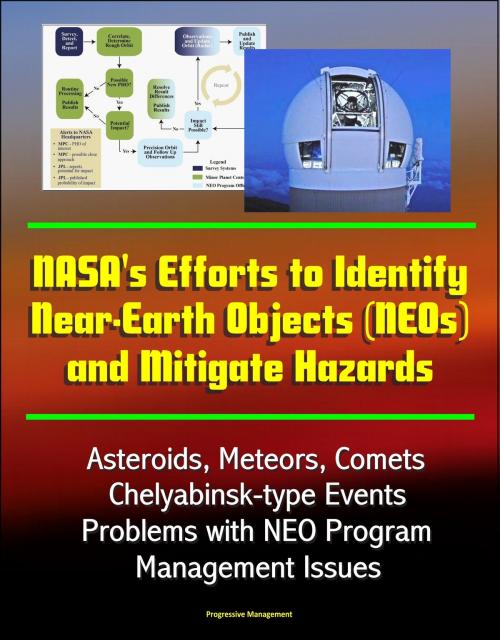NASA's Efforts to Identify Near-Earth Objects (NEOs) and Mitigate Hazards - Asteroids, Meteors, Comets, Chelyabinsk-type Events, Problems with NEO Program, Management Issues
Nonfiction, Science & Nature, Technology, Aeronautics & Astronautics, Science, Physics, Astrophysics & Space Science| Author: | Progressive Management | ISBN: | 9781310145223 |
| Publisher: | Progressive Management | Publication: | October 8, 2014 |
| Imprint: | Smashwords Edition | Language: | English |
| Author: | Progressive Management |
| ISBN: | 9781310145223 |
| Publisher: | Progressive Management |
| Publication: | October 8, 2014 |
| Imprint: | Smashwords Edition |
| Language: | English |
This recently released audit report of the NASA Office of Inspector General provides unique information about NASA's efforts to identify Near-Earth Objects (NEOs).
NASA has organized its NEO Program under a single Program Executive who manages a loosely structured conglomerate of research activities that are not well integrated and lack overarching Program oversight, objectives, and established milestones to track progress. In addition, NASA is undertaking NEO-related activities not managed by the Program and not sufficiently integrated into ongoing Program activities. Furthermore, NASA lacks formal agreements or procedures for NEO-related activities it conducts with other Federal agencies and foreign governments and has not taken advantage of possible partnership opportunities. Consequently, managers could not identify the level of resources required to adequately support the Program or explain how activities to which the NEO Program is contributing further Program goals. Even though the Program has discovered, categorized, and plotted the orbits of more than 11,000 NEOs since 1998, NASA will fall short of meeting the 2005 Authorization Act goal of finding 90 percent of NEOs larger than 140 meters in diameter by 2020. We believe the Program would be more efficient, effective, and transparent were it organized and managed in accordance with standard NASA research program requirements.
Lack of Structure and Limited Resources Hinders the NEO Program. Since creation of the NEO Program, the number of identified NEOs has increased from less than 500 in 1998 to over 11,000 as of July 2014. Most of this work occurred while the Program was relatively small - receiving only $4 million annually from FYs 2002 through 2009 and funding less than 20 individual efforts - and focused on identifying the largest NEOs.
However, with the directive to identify 90 percent of NEOs larger than 140 meters, substantially increased budget beginning in FY 2011, and additional projects, the NEO Program's existing structure and resources are inadequate to provide efficient, effective, and transparent program management.
This recently released audit report of the NASA Office of Inspector General provides unique information about NASA's efforts to identify Near-Earth Objects (NEOs).
NASA has organized its NEO Program under a single Program Executive who manages a loosely structured conglomerate of research activities that are not well integrated and lack overarching Program oversight, objectives, and established milestones to track progress. In addition, NASA is undertaking NEO-related activities not managed by the Program and not sufficiently integrated into ongoing Program activities. Furthermore, NASA lacks formal agreements or procedures for NEO-related activities it conducts with other Federal agencies and foreign governments and has not taken advantage of possible partnership opportunities. Consequently, managers could not identify the level of resources required to adequately support the Program or explain how activities to which the NEO Program is contributing further Program goals. Even though the Program has discovered, categorized, and plotted the orbits of more than 11,000 NEOs since 1998, NASA will fall short of meeting the 2005 Authorization Act goal of finding 90 percent of NEOs larger than 140 meters in diameter by 2020. We believe the Program would be more efficient, effective, and transparent were it organized and managed in accordance with standard NASA research program requirements.
Lack of Structure and Limited Resources Hinders the NEO Program. Since creation of the NEO Program, the number of identified NEOs has increased from less than 500 in 1998 to over 11,000 as of July 2014. Most of this work occurred while the Program was relatively small - receiving only $4 million annually from FYs 2002 through 2009 and funding less than 20 individual efforts - and focused on identifying the largest NEOs.
However, with the directive to identify 90 percent of NEOs larger than 140 meters, substantially increased budget beginning in FY 2011, and additional projects, the NEO Program's existing structure and resources are inadequate to provide efficient, effective, and transparent program management.















